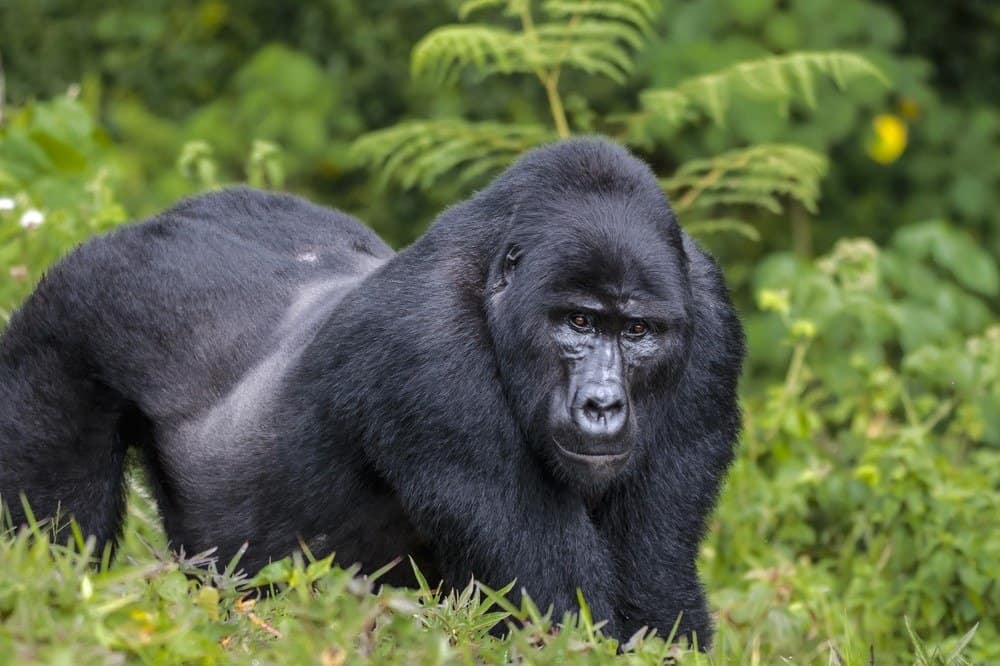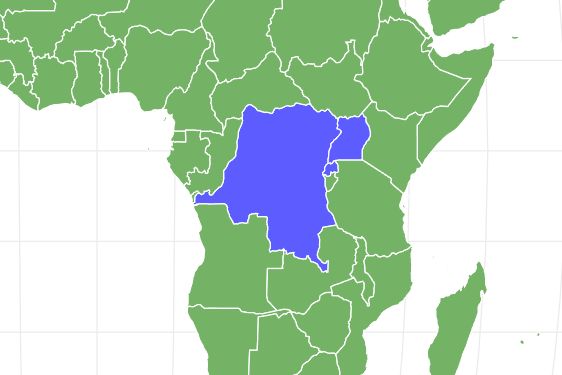Eastern Gorilla
.jumbotron {
background-image: url(“https://a-z-animals.com/media/animals/images/original/eastern_gorilla-398×300.jpg”);
}
}
@media only screen and (min-width: 641px) and (max-width: 920px) {
.jumbotron {
background-image: url(“https://a-z-animals.com/media/animals/images/original/eastern_gorilla-398×370.jpg”);
}
}
@media only screen and (min-width: 921px) {
.jumbotron {
background-image: url(“https://a-z-animals.com/media/animals/images/original/eastern_gorilla.jpg”);
}
}
The largest primate in the world!
Eastern Gorilla Scientific Classification
- Kingdom
- Animalia
- Phylum
- Chordata
- Class
- Mammalia
- Order
- Primates
- Family
- Hominidae
- Genus
- Gorilla
- Scientific Name
- Gorilla berengei
Read our Complete Guide to Classification of Animals.
Eastern Gorilla Conservation Status
Eastern Gorilla Facts
- Main Prey
- Leaves, Seeds, Herbs
- Habitat
- Tropical forest and jungles in mountainous regions
- Predators
- Human, Leopard
- Diet
- Omnivore
- Average Litter Size
- 1
This post may contain affiliate links to our partners like Chewy, Amazon, and others. Purchasing through these helps us further the A-Z Animals mission to educate about the world’s species..

Spiders that fly! Fish that walk! And 1000+ more incredible animals. Discover them all for FREE
.photo-gallery {
–margin: 0px auto 0px;
–padding: 0px 0px 0px 0px;
}
.gallery-link {
background-image: url(“https://a-z-animals.com/media/animals/images/original/eastern_gorilla.jpg”);
background-repeat: no-repeat;
background-size: cover;
background-position: center;
height: 500px;
justify-content: center;
text-align: center;
align-items: center;
display: flex;
border: 2px solid #000;
}
.gallery-link img {
height: 50%;
}
@media only screen and (max-width: 768px) {
.gallery-link {
height: 300px !important;
}
}
View all of the Eastern Gorilla images!
“The Eastern Gorilla is known as the largest living primate”
The eastern gorilla belongs to the genus gorilla. It is one of the great apes and is very closely related to humans. It is often observed that the eastern gorilla, which is most commonly found in jungles on mountain tops, comes with several features that made it easier for it to survive in the wild.
The eastern gorilla that goes by the scientific name Gorilla beringei is much closer to humans than first thought and can perform several tasks like peeling fruits by hand – much like humans. The eastern gorilla has two subspecies as of now – the eastern mountain gorilla and the eastern lowland gorilla, which is also known as the Grauer’s gorilla.
Incredible Eastern Gorilla Facts!
- Male eastern gorillas that are above 12 years of age experience a change of fur color – especially on their backs – that changes from black to grey, thus giving them the name “silverbacks.”
- Much like humans, the eastern gorillas have five fingers on each hand and five toes on each foot.
- Their nose prints can be used to identify each eastern gorilla, much like the fingerprints of human beings. It is unique and no two of them can ever be the same.
- Eastern gorillas have 32 teeth and relatively small ears.
- Eastern gorillas are very intelligent and have different ways of communication. They use about 25 different noises to communicate with each other.
Eastern gorilla scientific name
Commonly known as the Eastern gorillas, these creatures belong to the family and class of the great apes and mammals respectively and go by the scientific name Gorilla beringei and belongs to the genus gorilla.
The word “gorilla” has been derived from the history of Hanno who was a navigator and explorer and was on a tour to the West African coast. The members of the tour came across people who were later termed “gorillae.”
Even though it is unclear whether the expedition members encountered gorillas, a study of the specimen resonated with the description of what Hanno described them as, thus giving them the name.
The male members of the eastern gorilla families – often known as “silverbacks” as they age as the fur on their backs change from black to grey over the years – this giving them the name.
The eastern gorilla has two known subspecies – the eastern mountain gorilla and the eastern lowland gorilla.
Eastern gorilla appearance and behavior
Eastern gorillas are known to have strong, sturdy bodies that are covered with black colored fur. They have broad chests and long arms. However, the chest area, much like the face, hands, and soles of these gorillas is much less hairy than the rest of the body.
As males age, the fur at their back starts changing from black to grey. The mountain gorilla subspecies, however, have a bluish tainted fur that is usually shorter than the eastern gorillas.
The male eastern gorillas are, on average, about 1.7 meters in height (which is about the same height as the average person). However, they can also go up to 1.9 meters in some cases. Meanwhile, the female Eastern gorillas are usually only 1.5 meters tall.
Weight-wise, the male eastern gorillas usually swing between 300-440 lbs., while the females are usually about 195-220 lbs.
Eastern gorillas live in groups and their social interactions are based on the group they are a part of. The group is usually led by a silverback male, together with females and their offspring. Groups are often interconnected, comprising of 35 to 50 members each.
These gorillas are known to spend about 40% of their day relaxing and the other 30% doing food-related activities. The remaining day is usually spent roaming around. They are known to rest and sleep in their nests that are built on trees or sometimes also on the ground.
Most eastern gorillas are peaceful. However, some males are aggressive to assert their dominance.

Krasnova Ekaterina/Shutterstock.com
Eastern Gorilla Habitat
The eastern gorillas can be found in a variety of regions. Where they are found often depends upon the subspecies. The two subspecies are found in different areas – ranging from Uganda, Rwanda, and the Democratic Republic of Congo.
The eastern lowland gorilla or the Grauer’s gorilla is often found in the eastern part of the Democratic Republic of Congo. Meanwhile, the eastern mountain gorilla is further divided into groups that are distributed across regions.
Some of them live in Virunga mountains at about 1500 to 400 meters altitude above the sea level while the others can often be located in Bwindi national park in Uganda, where they usually live in steep mountains – between altitude 1100 to 2400 meters. Some other places that the eastern lowland gorillas reside in include the areas between the Tanganyika and Edward lakes and the Lualaba River.
Since much of the Eastern Gorillas’ life involves running or climbing, their impressive muscles give them strength along their upper body and down their arms. With fingers and thumbs like humans, they can easily collect food from high and low places.
Eastern Gorilla Diet
Sources suggest that the eastern gorillas are primarily herbivores, sourcing their nutrients from the vegetation in their natural habitat. However, the diet can vary from where they are located and how much altitude that they live.
The gorillas that are mostly found in the Bwindi area usually eat fruits. Otherwise, in other locations, the eastern gorillas can also feed on flowers, tree bark, and in some cases, even small invertebrates. Their diet also includes wild berries, fungi, and wood.
Eastern Gorilla Predators & Threats
The main threats that lurk upon the eastern gorillas are habitat degeneration, poaching, and violence in the areas that they reside in. It has been observed that many of these gorillas have died due to firing in their habitats. Leopards and the odd crocodiles are believed to be the major predators of the eastern gorillas. Meanwhile, the health threats to the eastern gorillas include microfilaria, Simian Immunodeficiency Virus, and Malaria.
The IUCN has declared the Eastern gorilla to be endangered and it is said that the population of these apes is consistently on a decline. The eastern mountain gorilla is at a higher risk of extinction. Sources suggest that as of now, only 300 mature eastern mountain gorillas are left. Meanwhile, the overall number of Eastern gorillas in the world are suspected to be less than 5,000.
Eastern Gorilla Reproduction, Babies, and Lifespan
The eastern gorillas have a polygynous reproduction system which means that the dominant male of each group mates with all the females in the clan. These gorillas are known to mate all year. Once conceived, the gestation period in the eastern gorillas typically lasts about 8.5 months, after which the female gives birth to a single baby. Females give birth only once every three to four years because of the long gestational periods as well as the parental process.
Immediately after birth, the baby is dependent on the parents – especially the mother who carries it around until it is ready to crawl by the time it is about nine weeks old. Their dependency lasts for the first four years, during which time the mother will nurse them as their primary source of food. Even when the baby no longer requires its mother’s milk, they will learn and play each day until they can take care of themselves.
Breeding may begin as early as 15 years old, though the lifespan of an eastern gorilla is usually 35 to 40 years. In captivity, these primates may live up to 50 years of age.
Eastern Gorilla Population
Currently, eastern gorillas are endangered, and the eastern gorilla population has been consistently decreasing over the past few years. During the 1990s, the population of these gorillas was estimated to be about 17,000. However, a recent report showed that the population has now fallen to less than 5000 and close to 4,000 around the globe.
It has also been observed that the eastern lowland gorillas now reside in only 13 percent areas of where they used to be found formerly. However, the eastern mountain gorilla is at a higher risk of extinction.
Conservation Efforts
Several projects have been initiated to conserve this endangered creature. One such project is the Walikale Gorilla and Forest Conservation Project that began in 2001 after the eastern gorilla population started declining.
They have been working on preserving the natural habitat for the gorillas to thrive in so that the habitat degeneration does not become a common cause for their decrease.
Other projects have been encouraging to initiate better tourism for the mountain gorillas so that funds can be raised to protect them. However, the public must be cautious to not be around the animal while being sick since any risk to the already endangered species should and must be avoided.
Eastern Gorilla in the Zoo
Reports suggest that the Antwerp Zoo in Belgium happens to be the only zoo that has a female eastern gorilla. However, the eastern mountain gorillas are not known to be kept in zoos within the United States at this time.
View all 68 animals that start with E
Eastern Gorilla FAQs (Frequently Asked Questions)
Are eastern gorilla carnivores, herbivores, or omnivores?
The eastern gorillas are usually herbivores in nature. Their diet usually includes fruits, bark, wood, flowers, and leaves. However, the diet also depends on where they are located and sometimes these gorillas also feed on tiny invertebrates.
Where does the eastern gorilla live?
The eastern gorillas can be found in a vast variety of places. They are found in different areas ranging from Uganda, Rwanda, and the Democratic Republic of Congo.
What’s the difference between an eastern gorilla and a western gorilla?
The Western gorilla is mostly found in areas ranging from Cameroon to the Republic of Congo while the eastern gorilla is found in Uganda, Rwanda, and the Democratic Republic of Congo.
The western gorillas are usually smaller and have a brownish-grey coat while the eastern gorillas have black fur and are much larger in shape and size.
How many eastern gorillas are left?
The conservation status of the eastern gorillas is endangered and there are only less than 5000 eastern gorillas left around the globe now as compared to the 10,000 in the 1990s.
How much does an eastern lowland gorilla weigh?
A typical male eastern gorilla weighs about 145-205 kg while a female eastern gorilla usually weighs about 90-100 kg.
What does the eastern gorilla eat?
The eastern gorilla usually eats fruits, flowers, leaves, barks, wood, and sometimes even tiny invertebrates.
Is the eastern gorilla endangered?
Yes. The IUCN classified the eastern gorilla as an endangered species in 2016, due to illegal poaching.
How fast is an Eastern Gorilla?
An Eastern Gorilla can travel at speeds of up to 25 miles per hour.
Sources
- David Burnie, Dorling Kindersley (2011) Animal, The Definitive Visual Guide To The World’s Wildlife
- Tom Jackson, Lorenz Books (2007) The World Encyclopedia Of Animals
- David Burnie, Kingfisher (2011) The Kingfisher Animal Encyclopedia
- Richard Mackay, University of California Press (2009) The Atlas Of Endangered Species
- David Burnie, Dorling Kindersley (2008) Illustrated Encyclopedia Of Animals
- Dorling Kindersley (2006) Dorling Kindersley Encyclopedia Of Animals
- David W. Macdonald, Oxford University Press (2010) The Encyclopedia Of Mammals
- Animalia, Available here: http://animalia.bio/eastern-gorilla
- Gorillas-World, Available here: https://www.gorillas-world.com/eastern-gorilla/
- Wikipedia, Available here: https://en.wikipedia.org/wiki/Eastern_gorilla
- World Wildlife Fund, Available here: https://wwf.panda.org/knowledge_hub/endangered_species/great_apes/gorillas/eastern_lowland_gorilla/
















